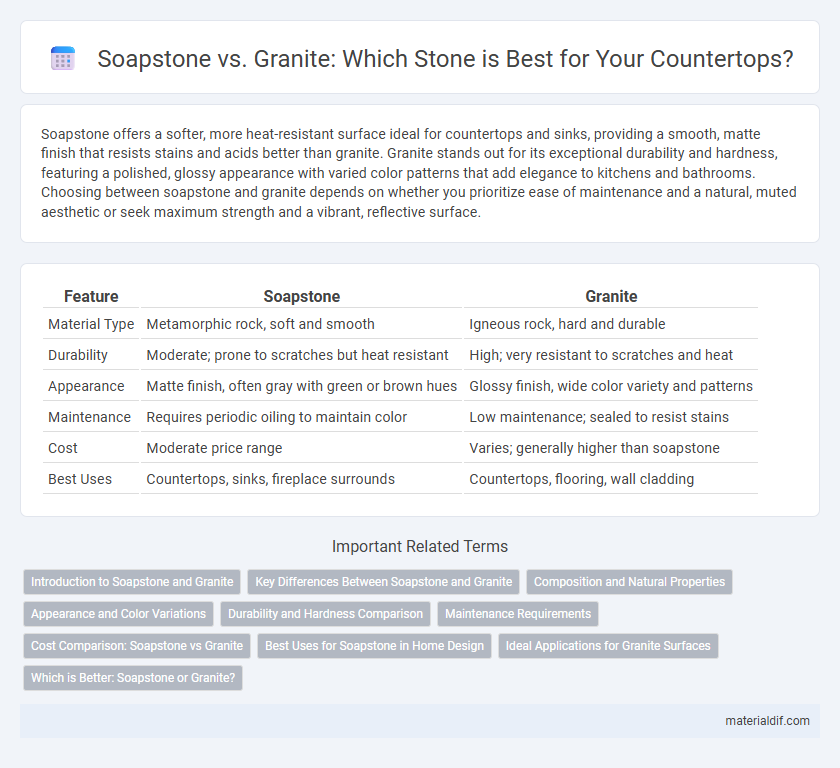Soapstone offers a softer, more heat-resistant surface ideal for countertops and sinks, providing a smooth, matte finish that resists stains and acids better than granite. Granite stands out for its exceptional durability and hardness, featuring a polished, glossy appearance with varied color patterns that add elegance to kitchens and bathrooms. Choosing between soapstone and granite depends on whether you prioritize ease of maintenance and a natural, muted aesthetic or seek maximum strength and a vibrant, reflective surface.
Table of Comparison
| Feature | Soapstone | Granite |
|---|---|---|
| Material Type | Metamorphic rock, soft and smooth | Igneous rock, hard and durable |
| Durability | Moderate; prone to scratches but heat resistant | High; very resistant to scratches and heat |
| Appearance | Matte finish, often gray with green or brown hues | Glossy finish, wide color variety and patterns |
| Maintenance | Requires periodic oiling to maintain color | Low maintenance; sealed to resist stains |
| Cost | Moderate price range | Varies; generally higher than soapstone |
| Best Uses | Countertops, sinks, fireplace surrounds | Countertops, flooring, wall cladding |
Introduction to Soapstone and Granite
Soapstone is a metamorphic rock primarily composed of talc, known for its softness, heat resistance, and non-porous nature, making it ideal for countertops and carving. Granite is an igneous rock characterized by its hardness, durability, and granular texture, commonly used in kitchen surfaces due to its resistance to scratches and heat. Both stones offer unique aesthetic and functional properties, with soapstone providing a smooth, matte finish and granite delivering a polished, speckled appearance.
Key Differences Between Soapstone and Granite
Soapstone is a softer, non-porous metamorphic rock primarily composed of talc, making it highly resistant to stains and heat, whereas granite is a hard, igneous rock made mainly of quartz and feldspar, known for its durability and scratch resistance. Granite typically features a more polished and glossy finish with varied color patterns, while soapstone has a smooth, matte texture that darkens over time. Maintenance for soapstone is easier due to its stain resistance, but it may require periodic oiling, unlike granite which often needs sealing to prevent moisture penetration.
Composition and Natural Properties
Soapstone primarily consists of talc, making it soft and highly heat-resistant, whereas granite is composed of quartz, feldspar, and mica, providing exceptional hardness and durability. Soapstone's natural properties include resistance to acids and heat, making it ideal for countertops and fireplaces, while granite's dense, crystalline structure offers superior scratch and stain resistance. Both stones' mineral compositions dictate their maintenance and functional uses in construction and design.
Appearance and Color Variations
Soapstone offers a smooth, matte surface with consistent gray, green, or bluish hues, often marked by subtle veining that adds a soft, natural charm. Granite displays a glossy, polished finish with vibrant, diverse color options ranging from white and pink to black and red, featuring intricate mineral patterns and speckles that create a dynamic, eye-catching appearance. The distinct texture and color variations make soapstone ideal for a muted, rustic look, while granite suits bold, vibrant designs with its rich and varied palette.
Durability and Hardness Comparison
Soapstone exhibits lower hardness on the Mohs scale, typically around 1 to 3, making it less resistant to scratches and dents compared to granite, which ranks between 6 and 7. Granite's superior durability stems from its dense composition of quartz and feldspar, providing exceptional resistance to heat, impact, and abrasion. Despite soapstone's softer nature, its ability to develop a patina over time offers a unique aesthetic durability, whereas granite maintains its polished, resilient surface under heavy use.
Maintenance Requirements
Soapstone requires minimal maintenance due to its non-porous nature, making it resistant to stains and bacteria without the need for sealing. Granite demands regular sealing to maintain its durability and prevent stains, especially in high-traffic areas like kitchens. Soapstone's softer surface may develop a patina over time, while granite remains hard and scratch-resistant with proper upkeep.
Cost Comparison: Soapstone vs Granite
Soapstone generally costs between $70 and $120 per square foot, making it more affordable than granite, which ranges from $90 to $200 per square foot depending on quality and origin. Installation costs for soapstone are typically lower due to its softer nature, while granite may incur higher expenses because of its hardness and complex fabrication requirements. Overall, soapstone offers a budget-friendly option with durable qualities, whereas granite commands a premium price for its variety and high-end appeal.
Best Uses for Soapstone in Home Design
Soapstone's natural heat resistance and non-porous surface make it ideal for kitchen countertops and fireplace surrounds, ensuring durability and easy maintenance. Its smooth texture and muted tones provide a warm, rustic aesthetic perfect for sinks, bathroom vanities, and hearths. Unlike granite, soapstone resists acid and stains, making it especially suitable for food preparation areas and high-use surfaces in the home.
Ideal Applications for Granite Surfaces
Granite surfaces are ideal for kitchen countertops, bathroom vanities, and high-traffic flooring due to their exceptional hardness and resistance to scratches, heat, and stains. Unlike soapstone, granite offers a wider range of colors and patterns, making it a versatile choice for both modern and traditional interior designs. Its durability and ability to withstand heavy use make granite surfaces well-suited for commercial spaces and outdoor applications such as patio tables and exterior cladding.
Which is Better: Soapstone or Granite?
Soapstone offers superior resistance to acids and heat, making it ideal for kitchen countertops where durability and low maintenance are priorities. Granite provides enhanced hardness and a wider range of colors and patterns, offering greater aesthetic versatility and scratch resistance. Choosing between soapstone and granite depends on whether the user values thermal stability and ease of upkeep or color diversity and surface hardness.
Soapstone vs Granite Infographic

 materialdif.com
materialdif.com